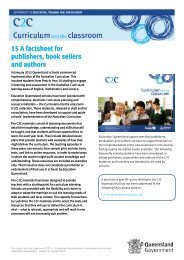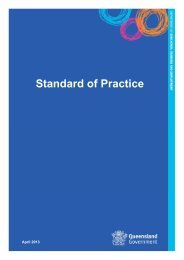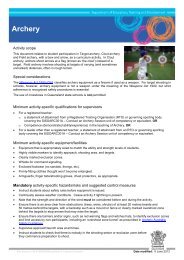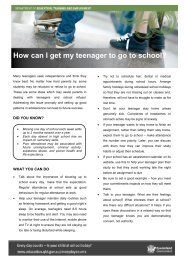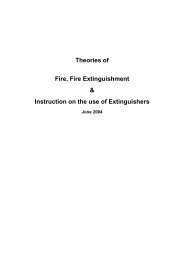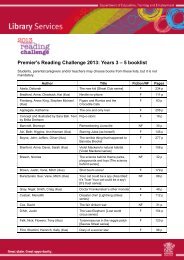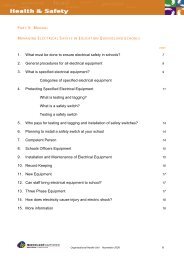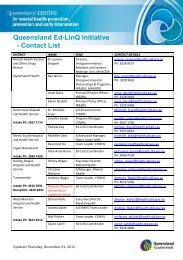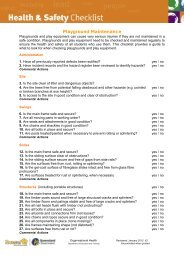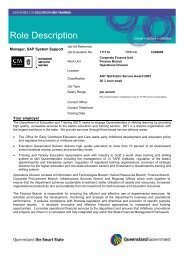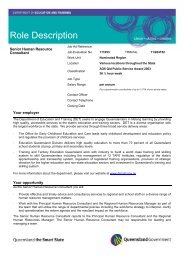Anaphylaxis guidelines for Queensland State Schools - Education ...
Anaphylaxis guidelines for Queensland State Schools - Education ...
Anaphylaxis guidelines for Queensland State Schools - Education ...
You also want an ePaper? Increase the reach of your titles
YUMPU automatically turns print PDFs into web optimized ePapers that Google loves.
- ensure that copies of the student’s Action Plan is placed in appropriate locations across the school<br />
to alert all staff to the student’s health condition and appropriate emergency response.<br />
• Ensure staff provide age-appropriate education to students regarding severe allergies. Age-appropriate<br />
peer education is important in reducing the risk of exposure. Peers are also able to alert teaching staff if<br />
they see a student with a history of allergy looking unwell.<br />
(See http://www.allergyfacts.org.au/links/online-store).<br />
• Ensure staff who supervise a student with anaphylaxis are confident in developing safe school activities<br />
which minimise exposure to known allergens.<br />
• Advise staff of students who have been given approval to self-administer and the conditions surrounding<br />
this.<br />
Organise staff training<br />
• Ensure a range of staff have completed the online ASCIA anaphylaxis e-training course <strong>for</strong> <strong>Schools</strong> and<br />
Childcare (<strong>Queensland</strong> version) at https://etraining.allergy.org.au/ and undergone practical training in<br />
the use of adrenaline auto-injectors (EpiPen® and Anapen®).<br />
• Ensure sufficient numbers of staff members have current first aid training (which includes<br />
cardiopulmonary resuscitation (CPR) and the administration of emergency asthma medication).<br />
• Consider the following when determining how many staff are to be trained:<br />
- the number of students diagnosed at risk of anaphylaxis<br />
- the curriculum and out-of-school activities in which these students participate<br />
- the level of associated risk with these activities<br />
- the impact of sick leave or other absences on staff availability<br />
- the ratio of trained staff required to meet the school’s emergency first aid response in the event of a<br />
first time presentation of anaphylaxis.<br />
• Consider the following personnel <strong>for</strong> training in emergency response to and treatment of anaphylaxis:<br />
- all staff who teach students who are at risk of anaphylaxis, including those who supervise specialist<br />
classes, non-contact time, elective classes and extracurricular activities including music<br />
- sports/physical education teachers including staff who supervise sports such as after-school<br />
practice/training sessions and interschool sport where relevant<br />
- teachers who deliver cooking lessons<br />
- science teachers<br />
- staff attending camps and/or excursions, special event days such as sport, music, per<strong>for</strong>ming arts,<br />
walkathons and cultural days<br />
- teacher aides<br />
- designated first aid officers<br />
- front office staff who are the first point of contact <strong>for</strong> visitors to the school<br />
- staff who supervise 'detention' sessions, eating and playground areas<br />
- tuckshop convenor and regular tuckshop helpers<br />
- relief staff<br />
- groundspeople.<br />
20 <strong>Anaphylaxis</strong> <strong>guidelines</strong> <strong>for</strong> <strong>Queensland</strong> state schools



